Ryan Hall's Blog, page 288
February 16, 2016
Unique Recovery Gear That Works
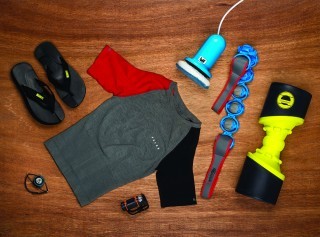
Photo: Greg Lambert
Recovery and self-care certainly aren’t as fun as lacing up for a run, but they’re essential to staying healthy and logging long miles. We rounded up some of the craziest gear and gadgets to help keep you injury-free, plus a few more to solve problems you didn’t even know you had.
Photo Gallery
1 of {count}
Back to Start
View Larger Image
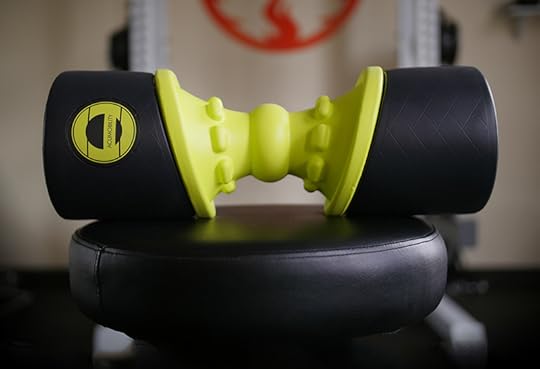
Acumobility Eclipse Roller, $70
With an unusual, angled notch, this model has four distinctly shaped zones, plus five pressure strips, to work different muscle groups. The result is a whole-body recovery workout with one tool.
View Larger Image
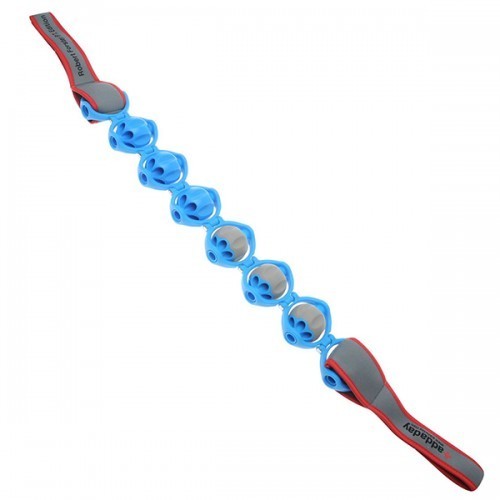
Addady Boomerang Massage Roller, $48
In addition to targeting hard-to-reach areas, this flexible strap has three medium and three hard massage balls for customized relief. Half of the balls also have a special coating that grips skin to truly work pesky knots and pressure points.
View Larger Image

BFF Turbo Electric Foam Roller, $300
It looks like a giant buffer, and it is. It even comes with different covers to smooth rough skin or massage in pain relief gel. The soothing vibrations also relax and rejuvenate muscles, increase blood flow, release tight fascia and treat trigger points. No rolling required.
View Larger Image
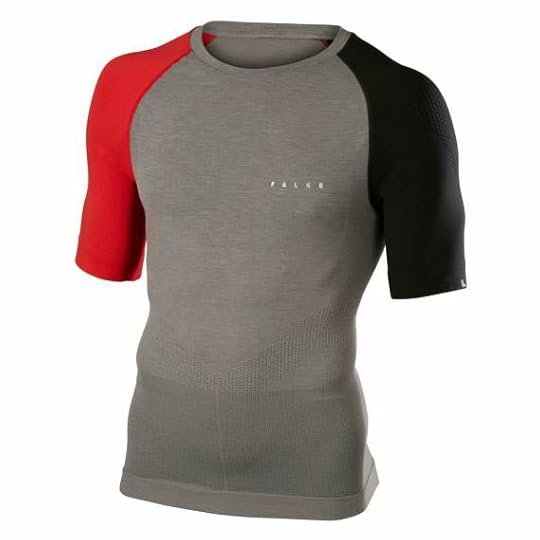
Falke Impulse Short-Sleeved Shirt, $220
Knitted and silicone nodules are incorporated into the shoulders and back of this sleek running shirt to stimulate fascia and, ideally, improve form. A patch in the lower back makes it difficult to fall into a late-run slump, while the shoulder nodules encourage better arm swing.
View Larger Image
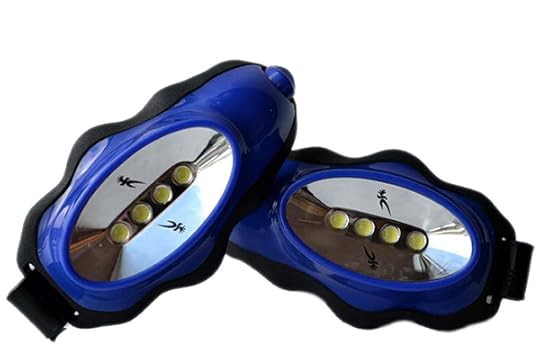
Knuckle Lights, $60
For those who don’t like wearing headlamps or carrying a flashlight, knuckle lights are an alternative nighttime solution. Each light shines 140 lumens in a flood beam pattern to illuminate your path. Sold in pairs, they come with rechargeable batteries and a charging stand.
View Larger Image
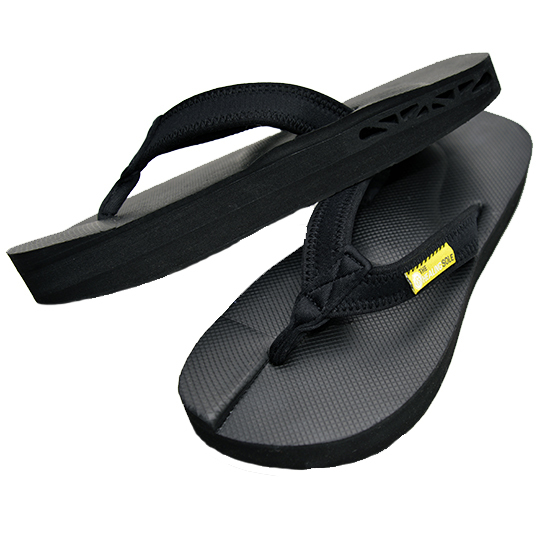
The Healing Sole Flip Flops, $150
Slide into these when you hop out of bed—or post-run for on-the-go healing. A raised platform for your big toe enables muscles to relax, medial heel cutouts cushion the plantar fascia, a firm sole and just enough arch structure provide support and a rockered sole reduces foot tension.
View Larger Image
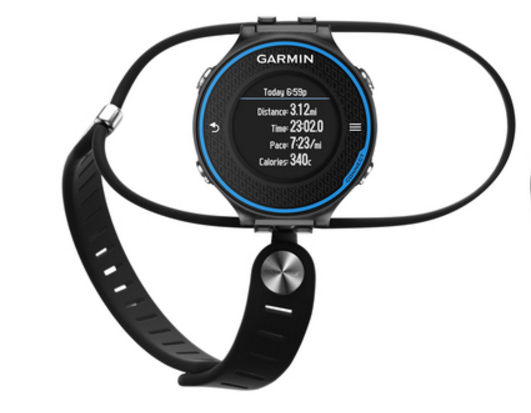
Shift Watch Band, $40
Made from flexible silicone, the band fits securely over the thumb and rests in your natural sightline for easy, on-the-run readability—meaning no awkward arm bending and no watch banging on your wrist bone. It comes in small, medium or large sizes, with attachments to fit most sport watches.
Related Galleries
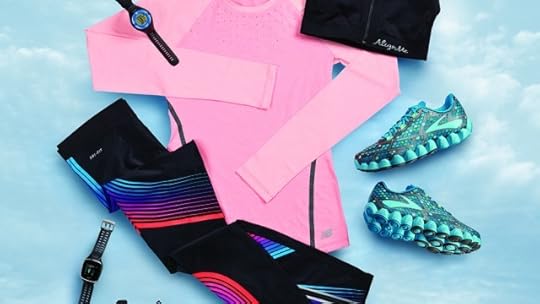
Cool Gear for the New Year

Bright Running Gear for Visible Nights

9 Dry Jackets for Wet Runs
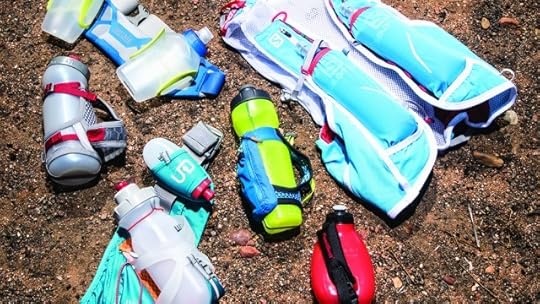
Closer Look: On-the-Go Hydration Gear

More Galleries
The post Unique Recovery Gear That Works appeared first on Competitor.com.
4 New Must-Read Running Books
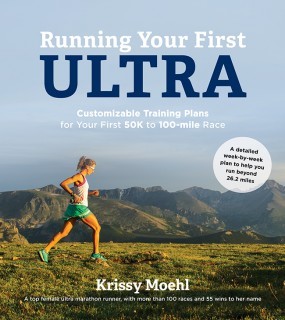
Four new books we recommend for late-winter running inspiration.
RELATED: The 25 Greatest Running Books of All-Time
Photo Gallery
1 of {count}
Back to Start
View Larger Image
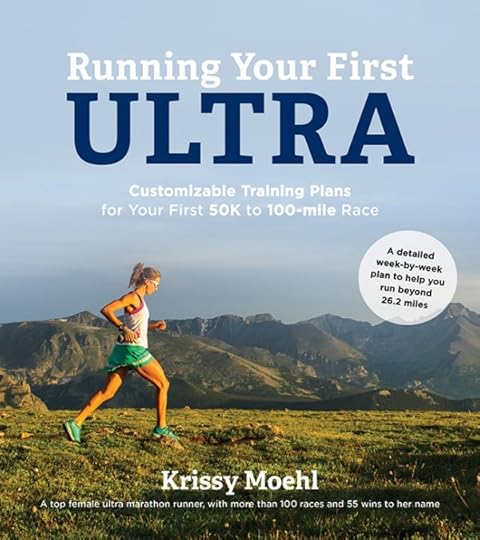
Running Your First Ultra: Customizable training plans for your first 50K to 100-mile race by Krissy Moehl
With 15 years of experience and more than 100 ultra races under her belt, there is no one more qualified to get runners across the ultra finish line. In “Running Your First Ultra,” Moehl provides runners with a comprehensive guide to training both the mind and body for these
grueling races. In addition to sharing stories about her own experiences on the trails, she provides customizable training plans and leaves room for readers to personalize the book by allotting space to write down goals and fill out a checklist before race-day.
View Larger Image
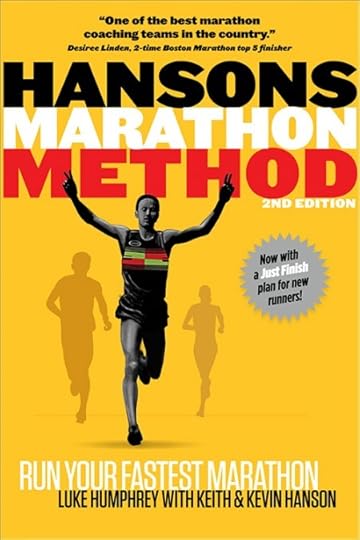
Hansons Marathon Method: Run your fastest marathon (2nd Ed.) by Luke Humphrey with Keith and Kevin Hanson
In the updated edition of “Hansons Marathon Method,” the coaches of the Hansons-Brooks Distance Project reveal their innovative marathon training program that has helped runners become true marathoners and outrun their personal bests. Their training approach tosses out mega-long runs and high-mileage weekends—two old-fashioned running traditions that often injure and discourage runners—in favor of spreading those miles more sensibly throughout the week. In this edition, the Hansons program welcomes newer runners with a new, lower-mileage “just finish” program.
View Larger Image
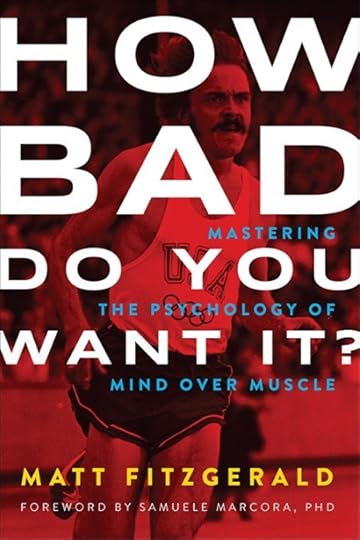
How Bad Do You Want It? Mastering the psychology of mind over muscle by Matt Fitzgerald
The greatest athletic performances spring from the mind, not the body. In “How Bad Do You Want It?,” Fitzgerald examines more than a dozen pivotal races to discover the surprising ways elite athletes strengthen their mental toughness. Each chapter explores the how and why of an elite athlete’s transformative moment, revealing powerful new psychobiological principles you can practice to flex your own mental fitness. The new psychobiological model of endurance performance shows that the most important question in endurance sports is: How bad do you want it?
View Larger Image
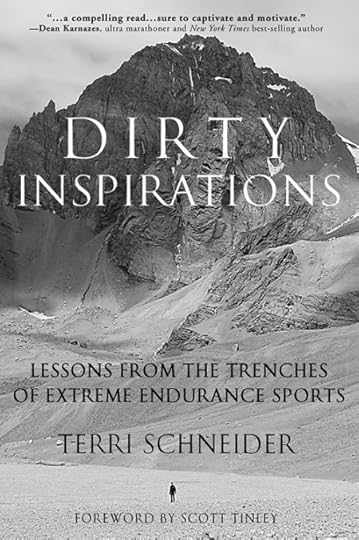
Dirty Inspirations: Lessons from the trenches of extreme endurance sports by Terri Schneider
In “Dirty Inspirations,” Schneider presents the unique perspective of a woman who has made it her life’s work to exceed her limits. The book takes readers through environments as majestic as they are unforgiving—from the brutal heat of the Sahara to the deep jungles of the Amazon and the awe-inspiring peaks of Denali in Alaska. Part philosophical journey, part spiritual awakening and part riveting drama, the stories presented in “Dirty Inspirations” embody the incredible resiliency of the human body and the indomitable nature of the human spirit.
Related Galleries

13 Running Books You Should Be Reading Right Now
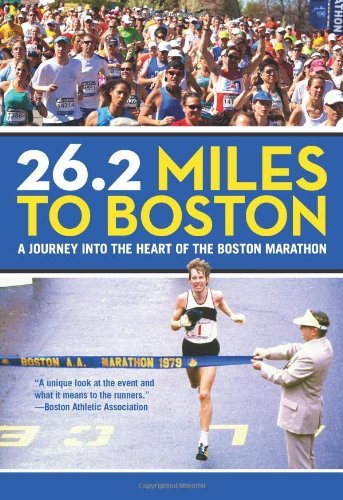
New Books About The Boston Marathon

5 New Books To Help You Stay Fit In 2014
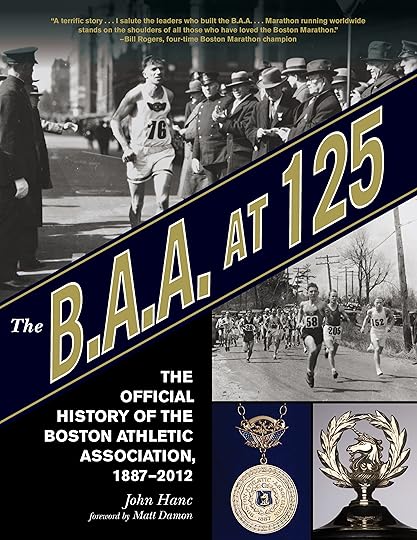
Summer Reading: 2013’s Best New Running Books

More Galleries
The post 4 New Must-Read Running Books appeared first on Competitor.com.
Why Runners Should Do Eccentric Training
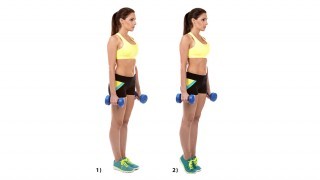
Common exercises like the calf raise can be made eccentric with a small tweak.
Eccentric training is a term that sounds complicated, but it’s really not—if you’ve ever tortured yourself with an exorbitant amount of hill runs, you’ve done a form of it. Eccentric training is simply capitalizing on the eccentric action of muscles, which occurs when tension is applied to a muscle as it lengthens. Consider your quads as you run downhill—they’re absorbing the weight of your body as they lengthen in order to control your descent. Without your quads working eccentrically on a downhill, you would quickly wind up with a mouth full of dirt/asphalt.
RELATED: The Upside of Downhill Training
Why Add Eccentric Training?
To put it simply, eccentric training will make you a more injury resistant and efficient runner. Remember those hills I talked about earlier? As many runners know from experience, hills can leave you with a nasty case of delayed onset muscle soreness (DOMS), the kind that makes sitting on the toilet a monumental and painful challenge. Eccentric training can help protect your muscles from the effects of DOMS via the repeated bout effect, which is an adaptation caused by a single bout of eccentric training that protects your muscles against damage from subsequent bouts.
All runners know flexibility is important; however, too much flexibility can be a detriment to your running performance simply for the fact that it has the potential to decrease musculotendinous stiffness, a quality critical for efficient transfer of energy. Eccentric training can help increase range of motion while maintaining and improving strength as well as increasing both dynamic and passive stiffness of the working muscles and tendons, thereby increasing running efficiency.
Lastly, running, particularly sprinting, requires significant work by the hamstring muscles, putting them at risk for injury. The strength and flexibility gains observed in eccentric training may reduce your risk of hamstring injury. A recent study published in The Journal of Strength and Conditioning Research found that an eccentric hamstring training program positively addressed different factors of hamstring strain injuries, by increasing eccentric and concentric strength, improving hamstring-to-quadriceps ratio (which also reduces your risk of knee injury), and increasing flexibility, ultimately reducing the subjects’ risk of hamstring injury.
How to Add Eccentric Training
If you’re sold on the potential benefits of eccentric training, it’s time to talk about implementation. To get the most out of an eccentric training program, it’s best to actually plan out specific training time, which may deter some of you since training time is hard to come by. The good news is, because eccentric training causes a decent amount of muscle damage (a good thing in moderation) you only need to do it once per week, twice maximum if you’re an overachiever. Another plus is the energy costs associated with eccentric training are relatively low, which means it won’t interfere with your running like traditional strength training can.
RELATED: 5 Reasons to Incorporate Unilateral Strength Training
Adding eccentric training can be as simple as adding a few extra hill descents into your current running routine. However, to get the full beneficial effect, it’s smart to hit all of the leg muscles, especially the hamstrings. Eccentric training can be performed using true eccentric exercises like Nordic hamstring extensions in which there is no concentric phase (when the muscle shortens under tension) or you can opt for traditional resistance exercises with an exaggerated eccentric phase. Exercises such as the hamstring curl, straight-leg deadlift, good morning, squat and calf raise can be used by shortening the concentric phase to one second and extending the eccentric phase to at least three seconds. For example, during a straight-leg deadlift lower down as slowly as possible until you feel a mild stretch in your hamstrings then quickly return to standing.
Working eccentric training into your current training program is relatively easy and inexpensive in terms of energy demands. Begin conservatively to avoid excessive muscle soreness. Choose two to three exercises per session, completing one to two sets of five to 10 repetitions with lighter weights. Gradually increase volume and weight as your tolerance and strength improves.
The post Why Runners Should Do Eccentric Training appeared first on Competitor.com.
February 15, 2016
Photos: More Amazing Images from the U.S. Olympic Trials Marathon
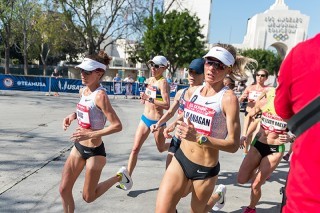
The U.S. Olympic Trials Marathon was held on Feb. 13 in Los Angeles. It was an amazing display of competitive racing, courage and perseverance as runners faced temperatures that reached the low-80s. Here are more images from the day of racing from photographer Matt Trappe.
RELATED: 2016 U.S. Olympic Trials Marathon Top 10 Finishers
RELATED: On to Rio—Rupp, Cragg Win U.S. Olympic Trials Marathon Titles
Photo Gallery
1 of {count}
Back to Start
View Larger Image
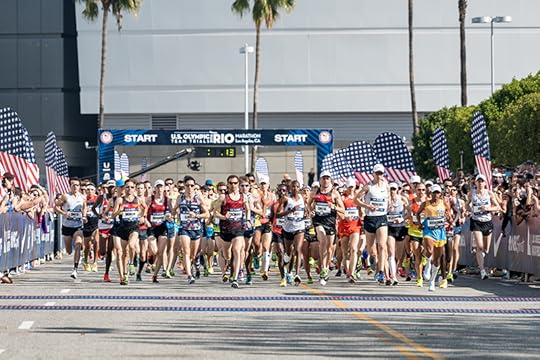
2016 U.S. Olympic Trials Marathon
Photo by Matt Trappe
View Larger Image
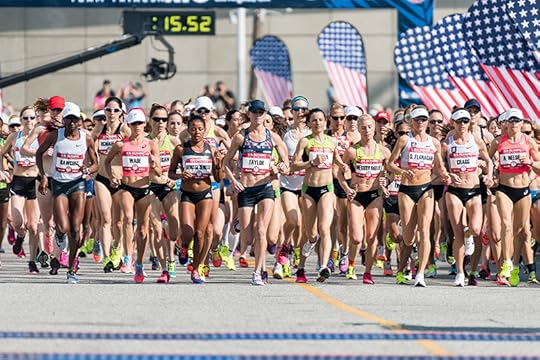
2016 U.S. Olympic Trials Marathon
Photo by Matt Trappe
View Larger Image
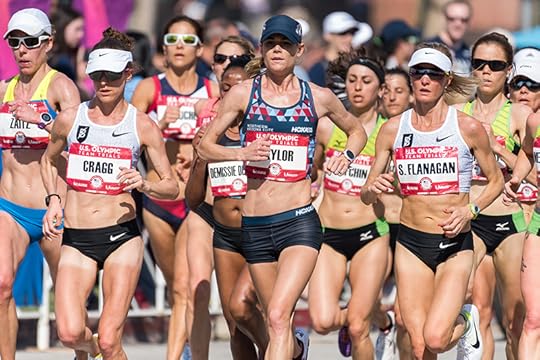
2016 U.S. Olympic Trials Marathon
Photo by Matt Trappe
View Larger Image
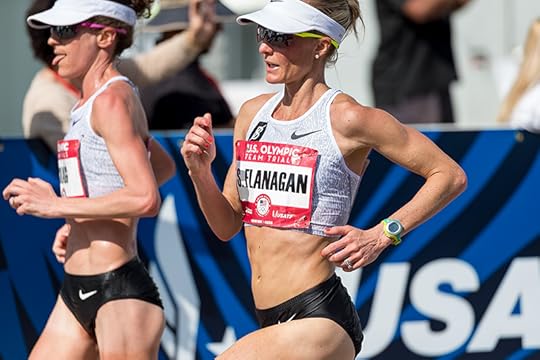
2016 U.S. Olympic Trials Marathon
Photo by Matt Trappe
View Larger Image
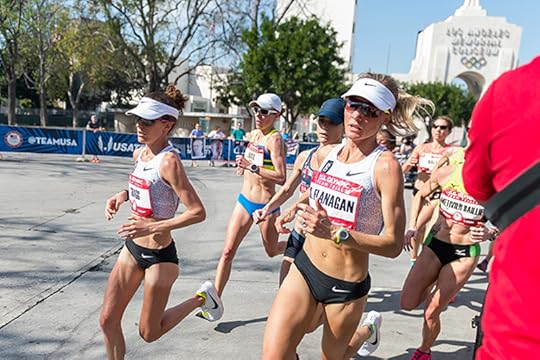
2016 U.S. Olympic Trials Marathon
Photo by Matt Trappe
View Larger Image
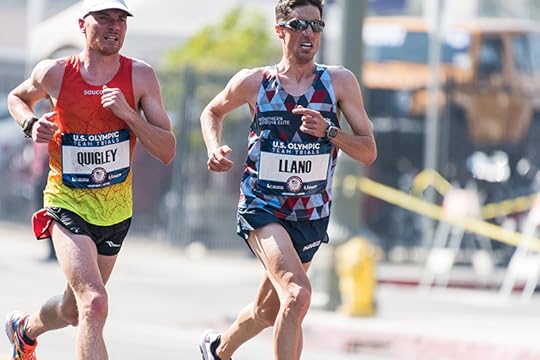
2016 U.S. Olympic Trials Marathon
Photo by Matt Trappe
View Larger Image
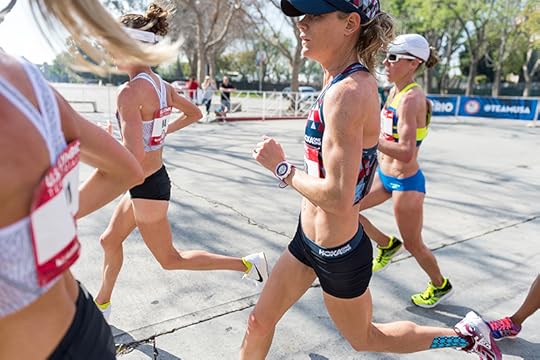
2016 U.S. Olympic Trials Marathon
Photo by Matt Trappe
View Larger Image
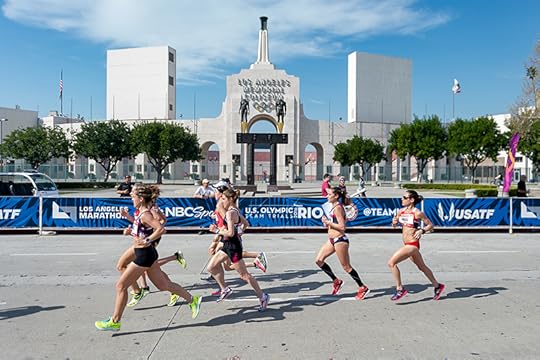
2016 U.S. Olympic Trials Marathon
Photo by Matt Trappe
View Larger Image
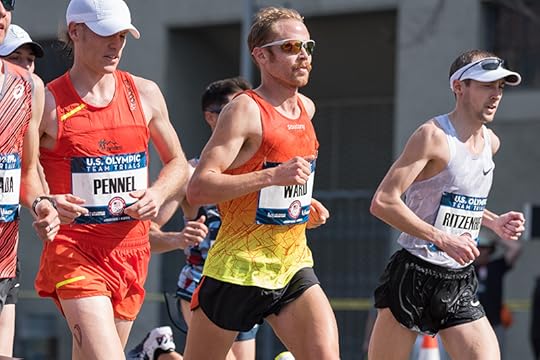
2016 U.S. Olympic Trials Marathon
Photo by Matt Trappe
View Larger Image
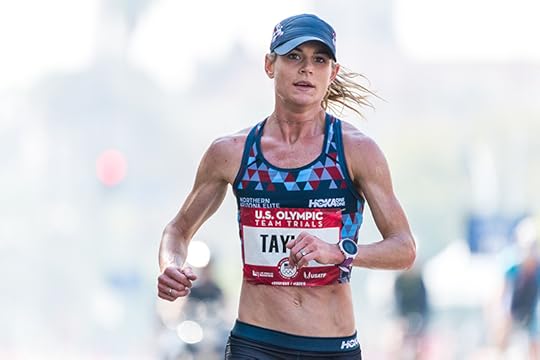
2016 U.S. Olympic Trials Marathon
Photo by Matt Trappe
View Larger Image
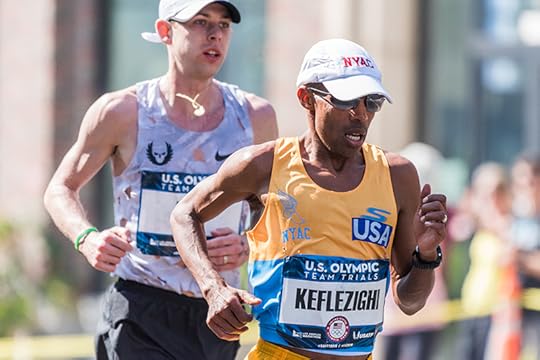
2016 U.S. Olympic Trials Marathon
Photo by Matt Trappe
View Larger Image
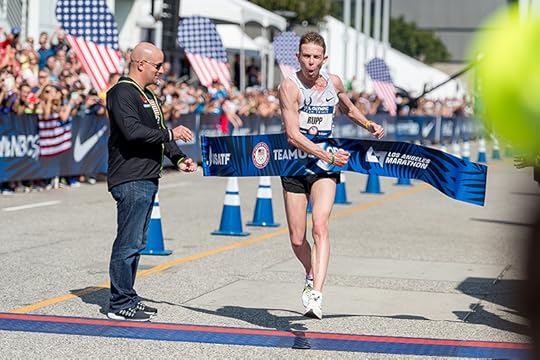
2016 U.S. Olympic Trials Marathon
Photo by Matt Trappe
View Larger Image
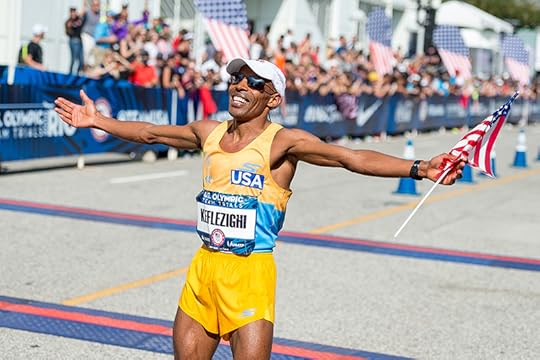
2016 U.S. Olympic Trials Marathon
Photo by Matt Trappe
View Larger Image
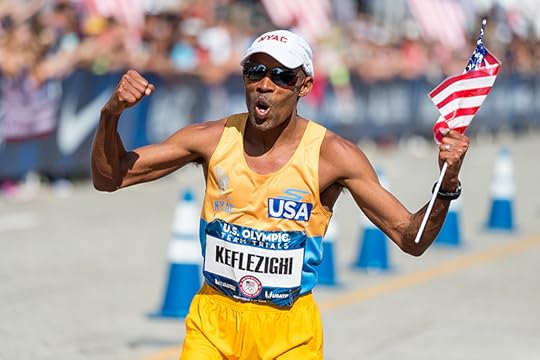
2016 U.S. Olympic Trials Marathon
Photo by Matt Trappe
View Larger Image
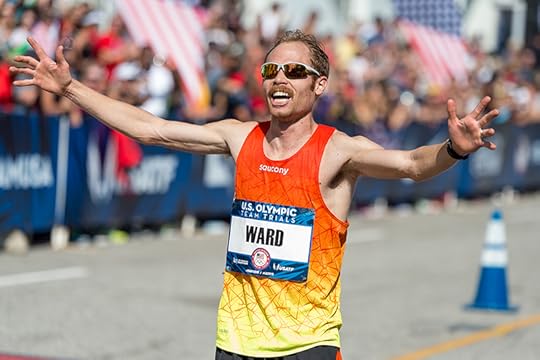
2016 U.S. Olympic Trials Marathon
Photo by Matt Trappe
View Larger Image
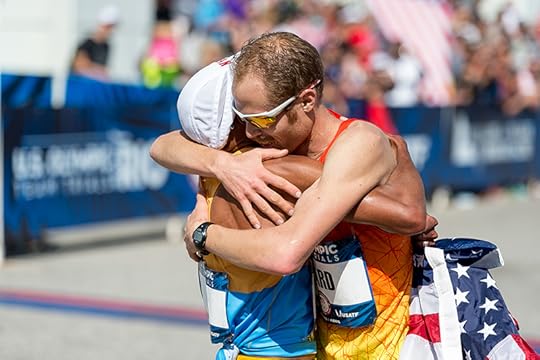
2016 U.S. Olympic Trials Marathon
Photo by Matt Trappe
View Larger Image
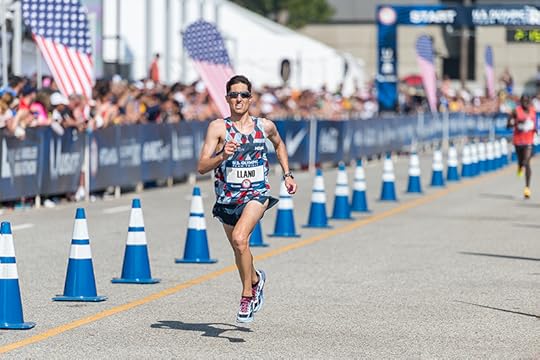
2016 U.S. Olympic Trials Marathon
Photo by Matt Trappe
View Larger Image
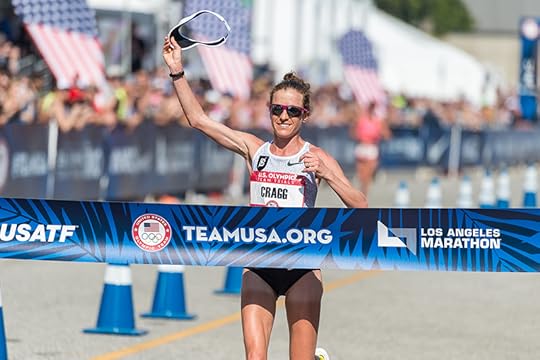
2016 U.S. Olympic Trials Marathon
Photo by Matt Trappe
View Larger Image
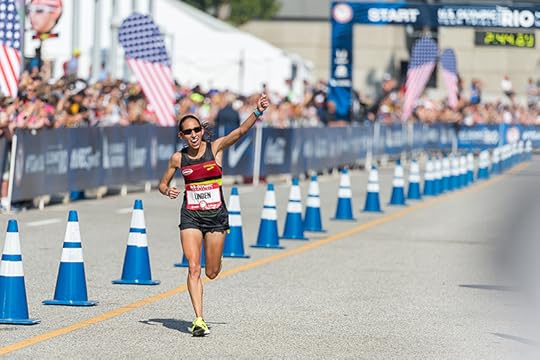
2016 U.S. Olympic Trials Marathon
Photo by Matt Trappe
View Larger Image
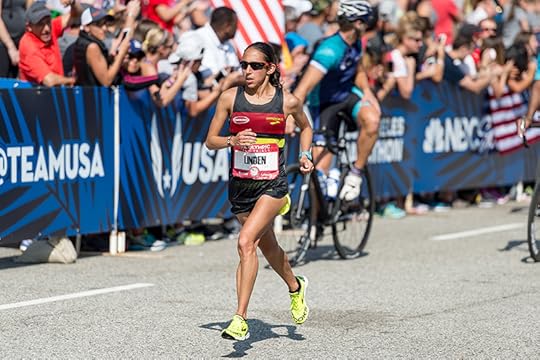
2016 U.S. Olympic Trials Marathon
Photo by Matt Trappe
View Larger Image
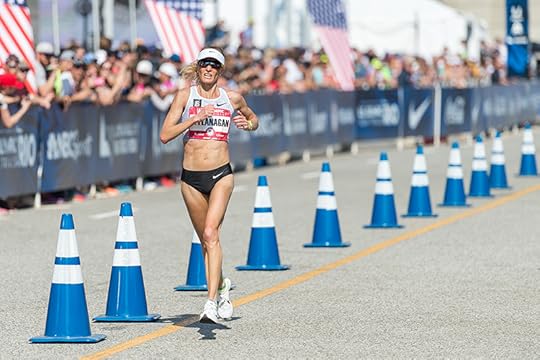
2016 U.S. Olympic Trials Marathon
Photo by Matt Trappe
View Larger Image
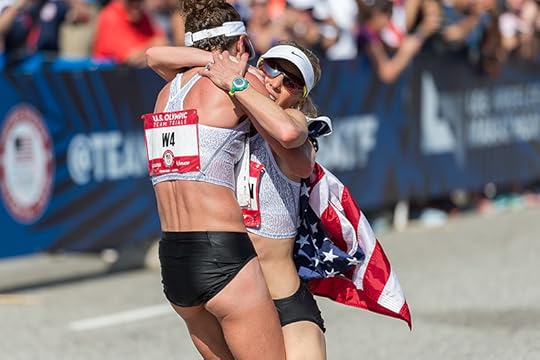
2016 U.S. Olympic Trials Marathon
Photo by Matt Trappe
View Larger Image
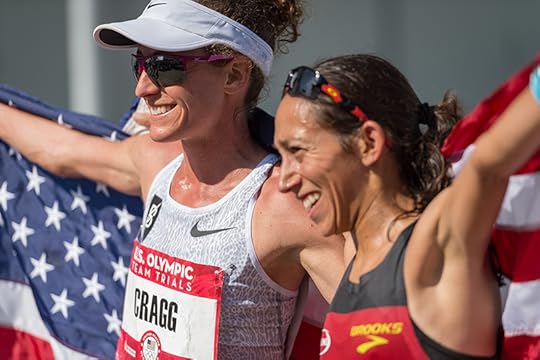
2016 U.S. Olympic Trials Marathon
Photo by Matt Trappe
View Larger Image
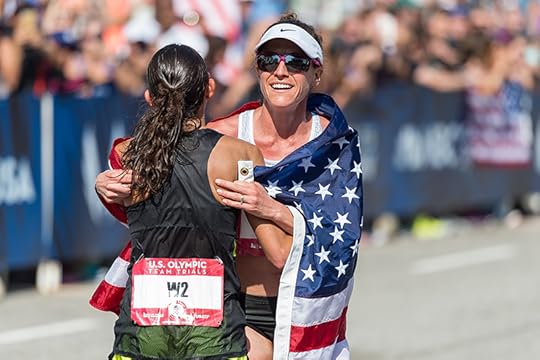
2016 U.S. Olympic Trials Marathon
Photo by Matt Trappe
View Larger Image
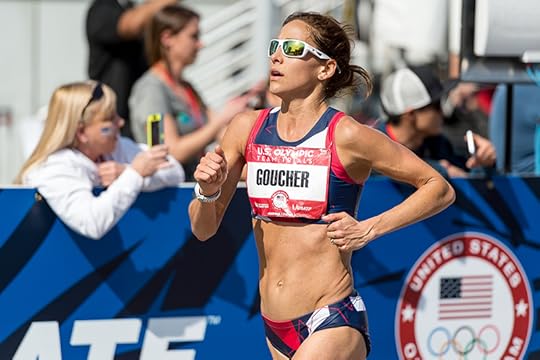
2016 U.S. Olympic Trials Marathon
Photo by Matt Trappe
View Larger Image
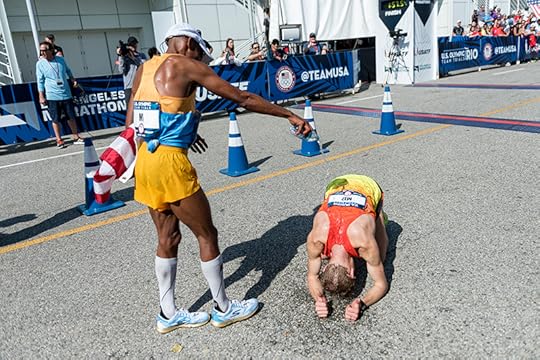
2016 U.S. Olympic Trials Marathon
Photo by Matt Trappe
View Larger Image
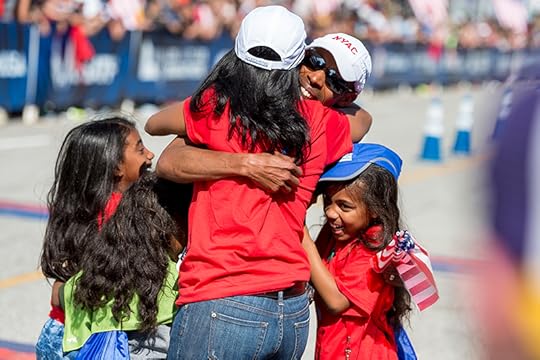
2016 U.S. Olympic Trials Marathon
Photo by Matt Trappe
View Larger Image
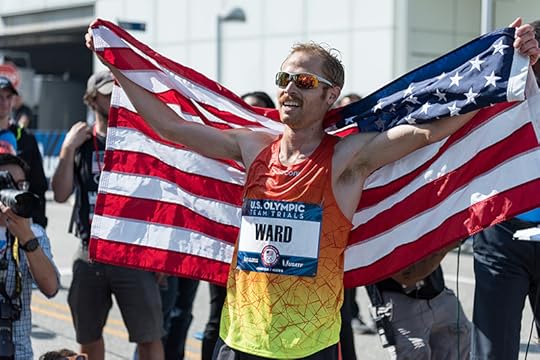
2016 U.S. Olympic Trials Marathon
Photo by Matt Trappe
View Larger Image
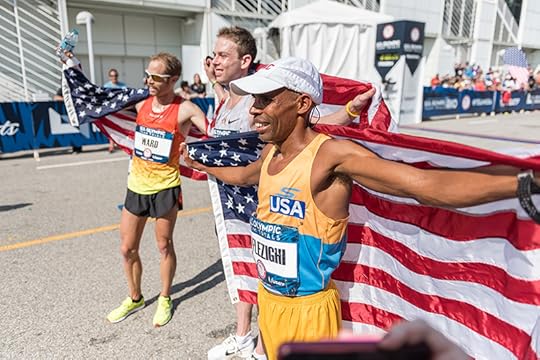
2016 U.S. Olympic Trials Marathon
Photo by Matt Trappe

More Galleries
The post Photos: More Amazing Images from the U.S. Olympic Trials Marathon appeared first on Competitor.com.
Kara Goucher Could Still Make the 2016 U.S. Olympic Team
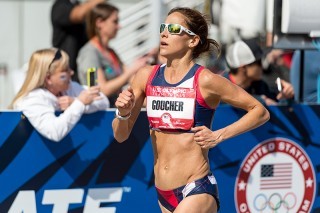
Kara Goucher ran a strong race but wound up in the hard-luck fourth-place position on Saturday at the U.S. Olympic Trials Marathon in Los Angeles. Photo: Matt Trappe
What’s next for Kara Goucher? Time will tell, but she could be racing again as soon as this spring.
After a strong but disappointing fourth-place finish in the U.S. Olympic Trials Marathon on Saturday in Los Angeles—disappointing because she missed an Olympic team berth by one place—Goucher reiterated that she’s got a lot of competitive fire left and is eager to race again. She’s said several times that, after her road racing and and track and field career winds down, she might even consider training for ultra-distance races.
But for now, the chance to make the 2016 U.S. Olympic team on the track and possibly run another big city marathon are very viable options for the 37-year-old two-time Olympian who lives in Boulder, Colo.
“I’m definitely not done,” she said late Saturday night. “Finishing fourth (is awful), but I gave it my best and I left it all out there. Once I recover from this, we’ll decide what’s next. But I will definitely race again. I didn’t fight this hard to get here to fold right now. So yeah, I’ll be trying to make the 10K team.”
Late Saturday night, Goucher brought a room to tears at a private Oiselle after-party at the Los Angeles Athletic Club as she gave a hearty thanks to her supporters and congratulated her fellow competitors. Oiselle, an upstart women’s athletic apparel company from Seattle that developed a partnership with Goucher two years ago, backed 18 runners in the women’s race, the most of any brand.
In a heartfelt two-minute talk, Goucher, wearing a pink and black dress, thanked her family and friends as well as coaches Heather Burroughs and Mark Wetmore and Oiselle founder Sally Bergesen and everyone else who supported her over the past two years. Goucher’s mother and sisters were at the race in Los Angeles to support her, as were several high school friends, her husband, Adam, and son, Colt.
Goucher said moving back to Boulder, Colo., in early 2014 to train under her former coaches Wetmore and Burroughs and developing new sponsor partnerships with Oiselle, Skechers and other companies helped give her a chance to continue her career when she wasn’t quite sure she could.
“Two years ago, this never would have happened. I was done. I didn’t even like the sport anymore,” she said. “And yet, the last 6 months I have never felt more alive. I’ve never felt happier.”
Goucher specifically gushed praise on Bergesen and Burroughs—who had each spoken moments earlier—amid a packed room on the third floor of the club. (Wetmore was coaching University of Colorado athletes at a meet in Seattle this weekend.)
“I can never thank you enough. I could never thank you enough,” Goucher said, pausing as she was overcome by emotion.
“This group of people is special,” she continued. “This group of people wants people to succeed, wants people to feel values, wants people to feel worthy. This is a safe place. Everyone here tonight, I feel like I owe a piece of my heart to each and every one of you. Thank you.”
PHOTOS: 2016 U.S. Olympic Trials Marathon
Burroughs said Goucher would take some down time to recover and then see how her body feels. From there, she could get back to training for a spring track season, with the possibility of running in 10,000-meter event at the U.S. Olympic Track & Field Trials on July 2 in Eugene, Ore.
Goucher placed 10th in the 10,000 at the 2008 Olympics in Beijing and won a bronze medal in the 2007 IAAF World Championships in that event in Osaka. She made the 2012 U.S. Olympic team in the marathon, placing 11th in the event at the London Olympics.
To race in this summer’s U.S. Olympic Track & Field Trials, she’ll need to break the 32:25:00 qualifying time before June 26. She’s run that fast several times—including her PR of 30:55.16 from the 2008 Olympics—but she has only run two 10,000 races on the track since the 2008 Olympics and none since 2013.
If she and her coaches choose that route, it’s likely that she’d race in the Payton Jordan Invitational at Stanford on May 1. Although it’s not the only option, that Sunday night meet typically has competitive 10,000 races and is often the best spring 10,000 race in the U.S. What are her chances of making the Olympic team? It might depend on how well she can respond to faster workouts (which she has been doing a lot since last fall) and who enters the race, but very likely be a legitimate contender.
Regardless of how that scenario plays out, Goucher could also retool her training to focus on a fall marathon, possibly the New York City Marathon. She made her marathon debut at the New York City Marathon in 2008 a few months after the Olympics, finishing third in 2:25:53. She returned to the Big Apple in 2014 but struggled on a cold, windy day when her fitness wasn’t quite there, placing 14th in 2:37:03.
For now, it’s all speculation, but the bottom line is that Goucher is eager to continue to compete at a high-level.
“Kara and Mark and I will sit down and talk about it all and decide what she’ll do next,” Burroughs said. “Ultimately it will be up to Kara and what she wants to do.”
RELATED: Sweet Redemption: Cragg Wins U.S. Olympic Trials Marathon
As for her race on Saturday, Goucher said she was pleased that she was competitive but disappointed to finish fourth, a little more than a minute behind third-place finisher Shalane Flanagan and the final Olympic team qualifying berth. Amy Cragg won the race in 2:28:20, followed by Desi Linden in second in 2:28:54 and Flanagan in 2:29:19. Goucher was next in 2:30:24.
At the 2012 U.S. Olympic Trials Marathon in Houston, Flanagan won, followed by Linden and Goucher, while Cragg was the fourth-place finisher.
“I had a dream that I’m going to have to let go of now,” Goucher told reporters after the race. “Obviously it’s a really hard pill to swallow, but they were better.”
RELATED: 2016 U.S. Olympic Trials Top 10 Finishers
Goucher started the race fairly conservatively toward the back of the lead pack of women and moved up after Cragg and Flanagan splintered the field with a decisive surge at the 10-mile mark. She was within 15 seconds of third place with about 5 miles to go but, Linden closed hard and eventually overtook Flanagan for second. Goucher knew the gap was too big to overcome in the final miles of the race but kept running as fast as she could to the finish.
“I think she ran great,” Burroughs said. “I thought she raced well and gave it everything she had on a hot and difficult day. The three women ahead of her ran great. They were the three other women we thought that would be in contention, so there were no surprises.”
Although the sting from missing the U.S. Olympic team by one spot was still evident, Goucher said she felt good physically a day after the race. She and husband, Adam Goucher, and their son, Colt, stayed an extra day in Los Angeles, meeting with some of the Skechers Performance team after the Los Angeles Marathon on Sunday and then spending some family time at the beach.
Goucher is technically the alternate for the U.S. Olympic team in the marathon, but she would only get the opportunity to race in Rio de Janeiro if Cragg, Linden or Flanagan were to pull out because of an injury or in the unlikely scenario that one of them intended to focus solely on the 10,000-meter run.
RELATED: Don’t Call It A Comeback—Kara Goucher Has Her Eyes on the Prize
Goucher said she realized that many people didn’t think she had a chance to make the Olympic team in the marathon, let alone be competitive in the race. But she said she didn’t train hard the past two years just to run a glorified “comeback” race. She wanted to make the team as much or more as she did in 2008 and 2012.
“I’ve been a dreamer,” Goucher told reporters moments after the race. “It’s just the way I’m wired. I love it still. I love racing, I love training, I feel alive when I’m preparing for something. I feel happy. Sometimes it doesn’t go the way you hoped, but I have such a good life. Mark and Heather taking me back, it just turned my life around. They brought me back to myself. They gave me my life back. I would do it again in a heartbeat, even with the same result. I wouldn’t even hesitate.”
The post Kara Goucher Could Still Make the 2016 U.S. Olympic Team appeared first on Competitor.com.
February 14, 2016
Photos: 2016 Moab Red Hot
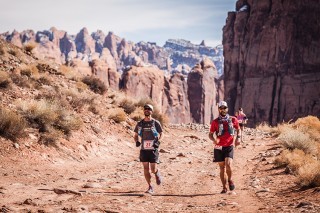
In one of America’s finest playgrounds for off-road adventure, the Moab Red Hot 55K/33K took place over the weekend in southern Utah. Runners had stunning views of the La Sal Mountains and Canyonlands National Park in what many ultrarunners consider a “kick off” race for 2016.
The 55K (about 34.1 miles) was won by Jim Walmsley of Flagstaff, Ariz., in a time of 3:49:20, while Brittany Goicoechea of Boise, Idaho was top female (and 13th overall) in 4:45:28. The 33K (20.5 miles) was won by Christian Gering (2:12:45) and Alicia Shay (2:39:56).
Here are photos from the race, taken by Derrick Lytle:
Photo Gallery
1 of {count}
Back to Start
View Larger Image

View Larger Image

View Larger Image

View Larger Image

View Larger Image

View Larger Image

View Larger Image

View Larger Image

View Larger Image

View Larger Image

View Larger Image

View Larger Image

View Larger Image

View Larger Image

View Larger Image

View Larger Image

Related Galleries

Photos: 2016 Los Angeles Marathon

Photos: 2016 Miami Marathon and Half Marathon

Photos: 2016 Carlsbad Marathon and Half

Photos: 2016 Houston Marathon and Half Marathon

More Galleries
The post Photos: 2016 Moab Red Hot appeared first on Competitor.com.
Photos: 2016 Los Angeles Marathon
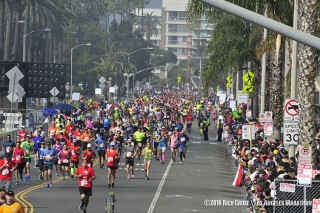
The Skechers Performance Los Angeles Marathon took place Sunday, taking runners from Dodger Stadium to the coastline of Santa Monica.
Weldon Kirui of Kenya in the men’s race and Nataliya Lehonkova of Ukraine in the women’s race led thousands of runners in the “Stadium to the Sea” course, taking place just one day after the U.S. Olympic Trials Marathon in downtown Los Angeles.
RELATED: Weldon Kirui, Nataliya Lehonkova Win L.A. Marathon
Here are photos from the race, taken by Rich Cruse:
Photo Gallery
1 of {count}
Back to Start
View Larger Image

Gathering at Dodger Stadium before sunrise.
View Larger Image

The annual photo with the legacy runners who have run all 31 Los Angeles Marathons.
View Larger Image

View Larger Image

View Larger Image

View Larger Image
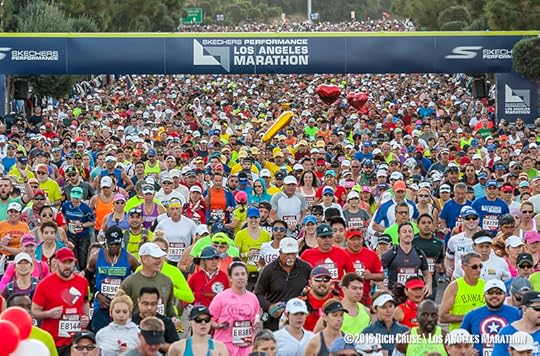
View Larger Image

View Larger Image

View Larger Image
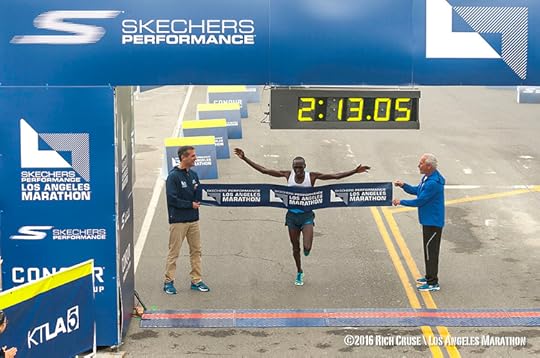
Weldon Kirui of Kenya won in 2:13:07.
View Larger Image
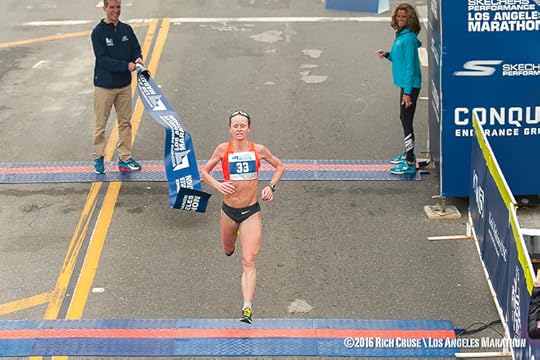
Nataliya Lehonkova of Ukraine won in 2:30:40.
View Larger Image
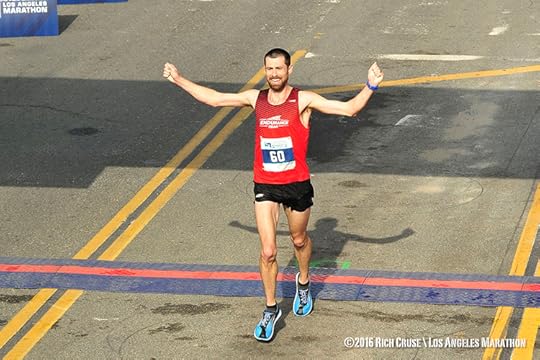
View Larger Image
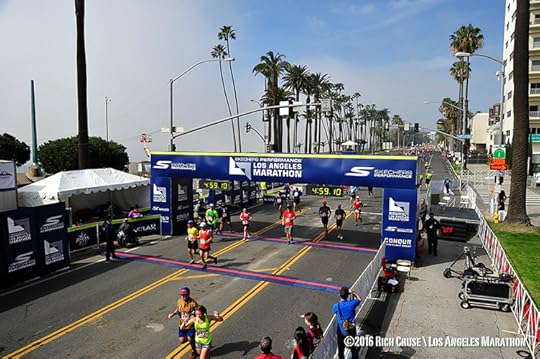
View Larger Image
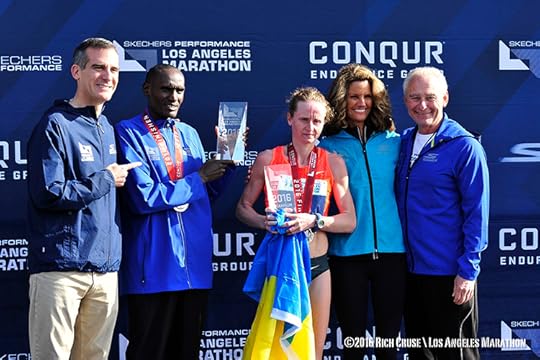
View Larger Image
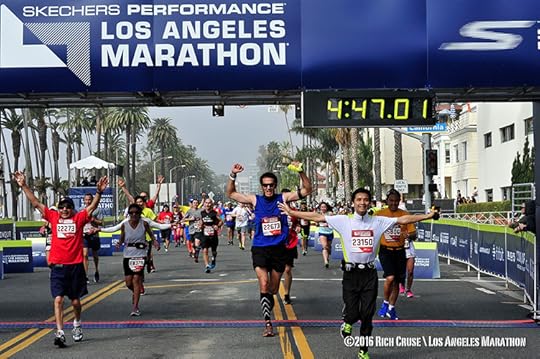
View Larger Image
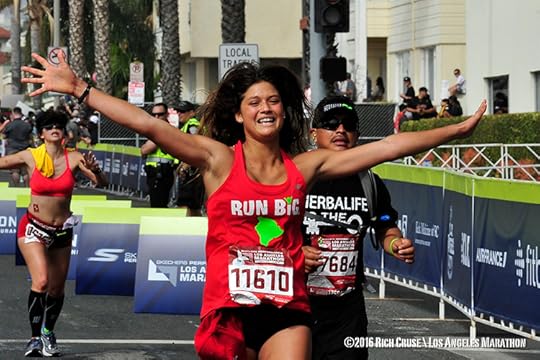
View Larger Image
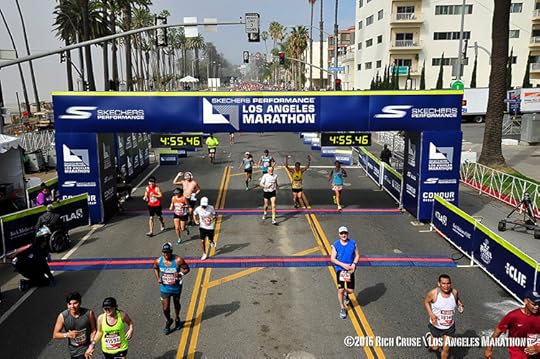
View Larger Image
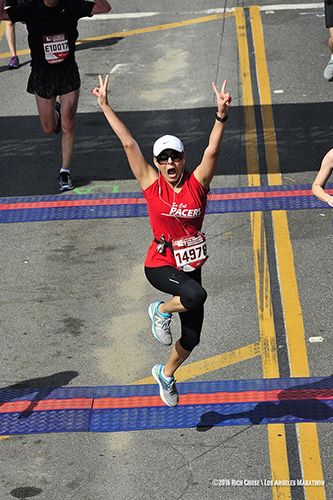
View Larger Image
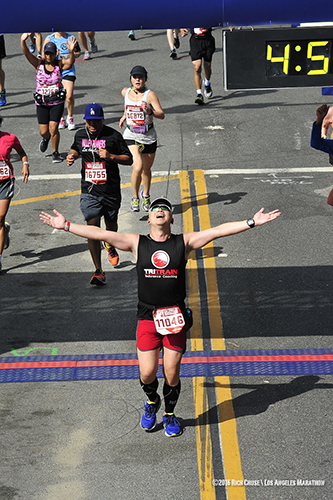
View Larger Image

View Larger Image

Related Galleries

Photos: 2016 Moab Red Hot

Photos: 2016 Miami Marathon and Half Marathon

Photos: 2016 Carlsbad Marathon and Half

Photos: 2016 Houston Marathon and Half Marathon

More Galleries
The post Photos: 2016 Los Angeles Marathon appeared first on Competitor.com.
Weldon Kirui, Nataliya Lehonkova Win L.A. Marathon
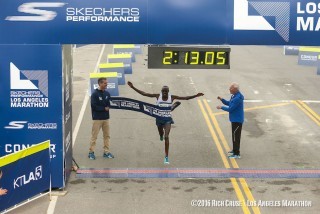
Weldon Kirui of Kenya breaks the tape on Sunday morning at the Skechers Performance L.A. Marathon. Photo: Rich Cruse | L.A. Marathon
Knowledge is power, and Weldon Kirui of Kenya used his previous course know-how to catapult himself to victory on Sunday morning at the Skechers Performance L.A. Marathon.
Sitting on countryman Willy Koitile for most of the last 7 miles of the race, Kirui made his move in the last mile to pull away decisively before the final turn onto Ocean Ave., in Santa Monica. He broke the tape with his arms spread wide in 2 hours, 13 minutes and 7 seconds, while a dejected Motile crossed 17 seconds later to claim runner-up honors. Defending champion Daniel Limo, also of Kenya, took third in 2:13:52.
“I was waiting till 40 kilometers and I was very strong,” said Kirui, a Skechers-sponsored athlete who finished fourth at L.A. in 2013 and second in 2011. “I knew the course very well. When I’m in training I normally stay in the back so I felt comfortable.”
Kirui’s mark was the slowest winning time at the L.A. Marathon since the race adopted its current Stadium to the Sea course in 2010. A casual early pace saw a pack of seven runners together through a 1:07:42 half-marathon split. That pack was cut to four by 30K before Koitile really shook things up with a move to the front. Kirui was the only one to go with him, and was content to sit behind his countryman until he was ready to strike.
“Last year I was injured and today I’m happy to finish in the second position,” admitted Koitile. “At 40K, Weldon had the energy to move and I am happy for him.”
Limo, who fell off the pace just past the 20-mile mark, held off a hard-charging Jacob Chemtai to secure his spot on the podium for the second straight year.
“I was trying to defend but it was tough competition today,” said Limo. “The guys were prepared. I tried to keep up but they were stronger than me.”
In the women’s race, Nataliya Lehonkova of Ukraine and Ethiopians Simgn Abnet and Serkalem Abrha separated themselves early, rolling through 10K together a tick under 36 minutes. Abnet fell off just before 20K and eventually dropped out, making it a two-woman contest for the win. Lehonkova made her move just after 30K, opening up a 10-second gap over the next 3 miles, en route to pulling away for victory in a new personal best of 2:30:40.
“I was just trying to run my pace,” explained Lehonkova, who ran 28 seconds faster than she did in winning the Dublin Marathon last fall. “I wasn’t thinking about winning. I was just trying to do my best time. I was pushing myself and I didn’t look to see if she was running behind me.”
Abrha was second in 2:32:23, while Julia Budniak, a Polish citizen who ran collegiately at USC and has lived in Los Angeles for the last 12 years, ran a three-minute personal best of 2:44:44. Budniak, who was running in fourth most of the race before Abnet dropped out, didn’t find out she was in third until about the 18-mile mark.
“I’m happy,” said the 34-year-old Budniak, who now coaches at Cal State L.A. “I feel home here. I know all the turns here really well.”
The post Weldon Kirui, Nataliya Lehonkova Win L.A. Marathon appeared first on Competitor.com.
February 13, 2016
Sweet Redemption: Amy Cragg Wins U.S. Olympic Trials Marathon
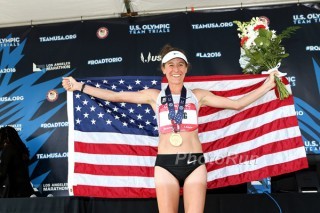
Photo: PhotoRun.net
LOS ANGELES—The women’s field at the 2016 U.S. Olympic Trials Marathon ran a hard race in the brutal and relentless Los Angeles heat. In the end, the runner who finished one spot shy of the podium at the 2012 Trials got her redemption in 2016: Amy Cragg, who won Saturday’s race in 2:28:20.
Desiree Linden stormed from behind to take second, and Shalane Flanagan placed third to round out the U.S. team that will compete in the Rio de Janeiro Olympics in August.
Within the first 5 miles, after the gun had gone off at 10:22 a.m., Cragg and Flanagan immediately took to the front of the pack and showcased a strong stride, fluctuating from a steady 5:37- to 5:50-mile pace. From the onset and for much of the race thereafter, it was obvious that the two Nike teammates who trained together through the build-up had dialed in their strategy to work together and grab two of the three spots for the Olympic team.
At mile 10, Flanagan and Cragg surged ahead of the group, leaving other top contenders such as Linden, Kara Goucher, Kellyn Taylor and Serena Burla behind.
It wasn’t until mile 25 when Flanagan started to lose steam and feel the heat. Cragg did what she could to talk her training partner through the rough patch and seeing Flanagan overheat, grabbed her a water bottle to pour over her head. Eventually, though, she had to leave Flanagan behind.
“With about a mile to go, I was keeping an eye on Des and I knew Kara wasn’t far behind her,” the 32-year-old Cragg recalled. “And I knew that was not a position I wanted to be in—the third/fourth position. Then I saw Des coming up and that’s when I decided I really needed to make a move, so I went forward.”
Cragg, who made the 2012 U.S. Olympic team in the 10,000-meter run, crossed the finish line victoriously in 2:28:20 and earned the $80,000 first-place prize check.
Linden passed Flanagan and raced ahead to take second in 2:28:54, running into Cragg’s arms.
“That was the toughest 26.2 miles ever,” said the 32-year-old Linden after the race. “It felt longer.”
An exhausted and overheated Flanagan then appeared around the final turn, falling across the finish line in third place and into Cragg’s embrace. Her time was 2:29:19.
RELATED: 2016 U.S. Olympic Trials Top 10 Finishers
“Sweet baby Jesus, I am so thankful for her,” Flanagan said of Cragg’s support through the final miles.
Needing immediate medical attention, Flanagan was swept out of Cragg’s arms and taken to the med tent. She gave a brief statement after the post-race press conference that she was unable to attend, saying “That was the hardest marathon I’ve probably run in terms of the last 6 miles being the hardest. I just got done getting an IV and I’ve never had one of those before. Clearly it took a toll on me today and it was a fight to make the team.”
Flanagan also added how she’ll need to work on her fueling in Rio de Janeiro, where it could exhibit even hotter and more humid temperatures. Temperatures ranged from 67 degrees at the start of Saturday’s race to 78 degrees near the finish, on a course with little to no shade.
PHOTOS: 2016 U.S. Olympic Trials Marathon
Besides the top three finishers heading to the Olympics, the rest of the field put up a good fight as well. Kellyn Taylor, a 29-year-old firefighter-in-training from Flagstaff, Ariz., positioned herself in third next to Flanagan and Cragg during the first 10K. She ended up finishing sixth in 2:32:50.
Throughout the first half of the race, Goucher seemed to settle somewhere in the middle of the lead pack with Sara Hall and Serena Burla. Occasionally, she broke wide of the group and surged up to third to catch Linden, but couldn’t hold it. Goucher finished fourth in 2:30:24, narrowly missing her third U.S. Olympic team berth.
Burla, a cancer survivor and mother from Washington, D.C., placed eighth in 2:34:22.
“If you made mistakes early, especially in the heat,” Linden said, “they’re magnified during the last miles.”
PHOTOS: Scenes from the 2016 U.S. Olympic Trials Marathon Course
The post Sweet Redemption: Amy Cragg Wins U.S. Olympic Trials Marathon appeared first on Competitor.com.
Galen Rupp Sizzles In Marathon Debut at U.S. Olympic Trials
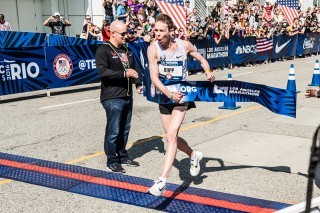
In his debut at 26.2 miles, Galen Rupp ran away with the 2016 U.S. Olympic Trials Marathon, crossing the finish line in 2:11:12. Photo: Ryan Bethke
LOS ANGELES—Beginner’s luck, rookie success, or whatever you want to call it, the first time was the charm for Galen Rupp on Saturday at the U.S. Olympic Trials Marathon in toasty downtown Los Angeles.
Competing in hot, dry conditions, the 29-year-old made his 26.2-mile debut a memorable one, running away from defending Trials champion Meb Keflezighi over the final 4 miles to win in 2 hours, 11 minutes and 12 seconds. Keflezighi held on for second in 2:12:20 while Jared Ward, who won last year’s U.S. marathon title, was third in 2:13:00 to round out the U.S. team that will compete in the Rio de Janeiro Olympics in August.
“I’m very excited with the way it went,” Rupp said after the race. “It’s always a tremendous honor to represent the United States. It’s the greatest honor on Earth. I’m so happy to be able to make my debut here and to be able to win was unbelievable. I’m so honored to be going to the Olympics.”
RELATED: 2016 U.S. Olympic Trials Marathon Top 10 Finishers
Rupp, who bided his time early and stayed tucked in amongst the lead pack, came through halfway with the leaders in 1:06:31. He stayed alongside Keflezighi when 2014 U.S. marathon champion Tyler Pennel opened up a slight gap after the 16-mile mark. By Mile 17, Keflezighi, Rupp and Pennel were running together again, but a 4:46 19th mile and 4:54 20th mile proved too much for Pennel.
“Tyler made that race,” Keflezighi said in the post-race press conference. “It was a good change of pace.”
Ward, who caught Pennel at Mile 21, concurred, saying that Pennel’s move caused him a slight bit of panic.
“When Tyler made that move, and Meb and Rupp went with him, I thought that’s a hard move,” Ward said. “If they can make it, I’m not going to catch them. So I went as fast as I could and I ran 4:50 that mile, and I’m sure that was my fastest mile. It was just hang on and I saw Tyler coming back and when I caught him, that was an adrenaline rush.”
PHOTOS: 2016 U.S. Olympic Trials Marathon
At the front, Rupp and Keflezighi ran together in tight quarters, and at several points over the next couple miles, Keflezighi was seen signaling to Rupp to give him some space.
“It’s not a track, the road is open,” Keflezighi said after the race, admitting it wasn’t a friendly conversation out on the roads.
Keflezighi was visibly pressing at mile 20, the strain on his face apparent in his effort to shake the lanky, long-striding Rupp. Just past the 22-mile mark, the marathon debutant decided it was time to put his foot on the gas, pulling away from his 40-year-old opponent with a hard 4:47 split to Keflezighi’s 5:05.
“At the beginning I was just trying to conserve as much energy as possible,” Rupp explained after the race. “After halfway, I thought I needed to cover every move. I didn’t know how my legs were going to feel those last few miles.”
Covering his last 3 miles in 4:52, 4:47 and 5:01, Rupp ran the second half of the race in 1:04:41, a near two-minute negative split on a day that was 66 degrees at the start of the race and 78 by the time all was said and done.
“Running with him, hopefully we gave the crowd some excitement,” the ever-gracious Keflezighi said after the race. “He gave a great effort and was great at the end. I’d like to congratulate him. I’m his teammate going to Rio.”
Ward, who wrote his masters thesis on optimal pacing strategies for the marathon, ran just 4 seconds off his personal best of 2:12:56, which he set at last year’s L.A. Marathon in similarly warm conditions.
“Eight hundred meters to go was the hardest thing of my life,” said Ward, who ran first and second half splits of 1:06:31 and 1:06:29 on Saturday. “With 600 meters to go, I started singing that song and changing the words. I said, ‘do it for your momma, do it for your wife, do it for your kids and do it for your life.’ It was just enough and that was the end of it.”
In winning the race, Rupp earned an $80,000 paycheck and secured his third U.S. Olympic team berth, having also made the team in the 10,000-meter run for the 2008 Olympics in Beijing and the 5,000 and 10,000 for the 2012 Olympics in London.
The silver medalist in the 10,000 in London, Rupp said he still considers that race his best event. He said he wants to compete in the World Indoor Track & Field Championships next month in his hometown of Portland, Ore., and has talked about attempting a 10,000/marathon double in this summer’s Olympics.
“I didn’t want to get ahead of myself, and everything leading up to this was all about the marathon,” he said. “I think that the double, with the way the schedule is, is a real possibility.
“This is kind of an interesting build-up because I definitely want to come back and try to run World Indoors in my hometown of Portland, Oregon. We had to do the marathon stuff. I had to do enough speed work to enable me to be able to come back after this and to continue to sprint I didn’t want to start from scratch with that. I think that the double in Rio is certainly possible. There’s a lot of time between the 10K and the marathon. The 10K is the shorter event. If the marathon were first, it would pretty much be impossible to double like that.”
The post Galen Rupp Sizzles In Marathon Debut at U.S. Olympic Trials appeared first on Competitor.com.
Ryan Hall's Blog
- Ryan Hall's profile
- 21 followers



